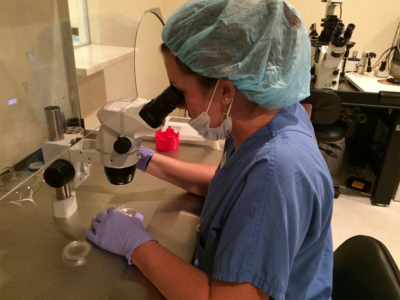Assisted Hatching
Assisted hatching at a glance
- Assisted hatching is a microscopic laboratory procedure designed to increase the chances of pregnancy by thinning the embryo’s outer shell from which the embryo must “hatch” before it can implant in the uterus.
- Assisted hatching is an additional step added to in vitro fertilization (IVF) and is often recommended after two or more failed IVF attempts.
- The procedure increases certain risks to the embryo but may also increase the chance for successful pregnancy.
What is assisted hatching?
This is a procedure in which the outer shell (zona pellucida) of a fertilized egg is gently thinned or ruptured using either an enzyme, specialized chemical solution or laser. For pregnancy to occur, the embryo must first shed the zona pellucida.
This process, known as hatching, usually occurs naturally around five to seven days after the egg is fertilized, becoming an embryo. At this time the contraction and expansion of the embryo allows enzymes to create the opening in the zona pellucida.
Sometimes embryos fail to hatch on its own, often due to an abnormally thick zona pellucida or other deficiencies in the embryo’s makeup. This assistance aids the embryo in the natural hatching process and may increase the chances of successful implantation and pregnancy.
Who might benefit from this infertility treatment?
The procedure isn’t recommended for all IVF patients, according to the American Society for Reproductive Medicine. Fertility specialists may recommend that the IVF lab perform assisted hatching before embryo transfer if the woman’s reproductive profile indicates she may have problems with successful implantation.

Assisted hatching may be recommended for women:
- Age 38 or older
- With at least two previous IVF failures
- Whose embryos have a thick zona pellucida, or shell
- Whose embryos were frozen for preservation, as freezing can make it harder for embryos to hatch
- Who use preimplantation genetic testing during IVF, as hatching is necessary to perform a biopsy on embryo cells
- Whose eggs or embryos are of poor quality.
How is this performed on the embryo?
Thinning or rupturing of the zona pellucida is accomplished in one of several ways:
- Laser-assisted hatching, in which the zona pellucida is ruptured using a targeted microscopic laser
- An acidified liquid called Tyrode’s solution may be introduced to the shell, causing an opening
- The application of proteolytic enzymes that the embryo normally produces to naturally break down tissue, in order to thin the zona pellucida.
Risks of assisted hatching
According to the American Society for Reproductive Medicine, the procedure is associated with an increased risk of embryo damage and a decreased chance of embryo viability. This assistance in hatching is also associated with an increased risk of identical twins, which carries increased health risks for mother and her twins.
If a woman is struggling to achieve pregnancy via IVF, the potential for a successful IVF cycle using assisted hatching may outweigh these risks. Women and couples should discuss these issues with their fertility physician beforehand.
Interested in learning more?
Make an appointment to discuss assisted hatching and other fertility treatments. Get Started


